Page 374 of 478
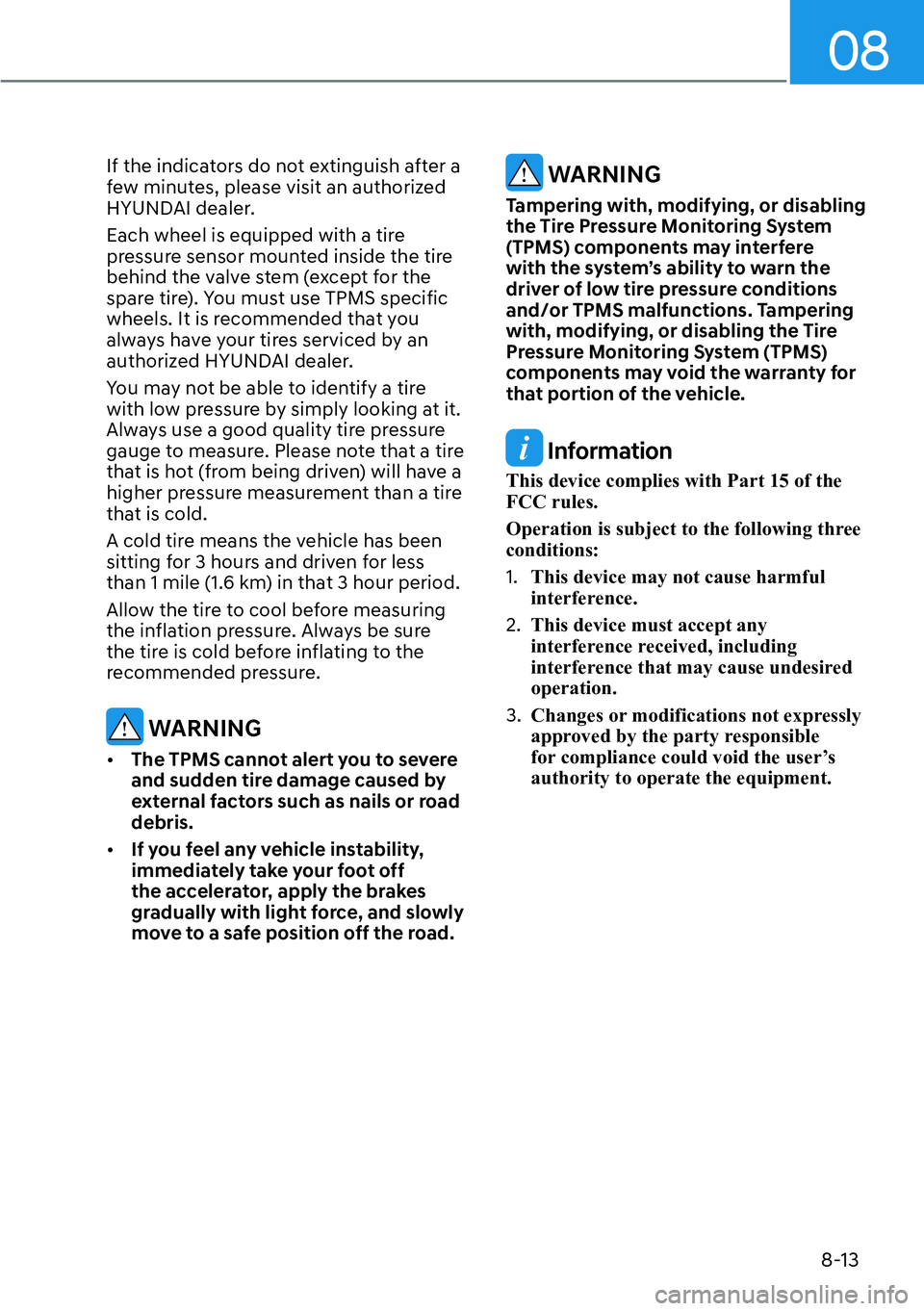
08
8-13
If the indicators do not extinguish after a
few minutes, please visit an authorized
HYUNDAI dealer.
Each wheel is equipped with a tire
pressure sensor mounted inside the tire
behind the valve stem (except for the
spare tire). You must use TPMS specific
wheels. It is recommended that you
always have your tires serviced by an
authorized HYUNDAI dealer.
You may not be able to identify a tire
with low pressure by simply looking at it.
Always use a good quality tire pressure
gauge to measure. Please note that a tire
that is hot (from being driven) will have a
higher pressure measurement than a tire
that is cold.
A cold tire means the vehicle has been
sitting for 3 hours and driven for less
than 1 mile (1.6 km) in that 3 hour period.
Allow the tire to cool before measuring
the inflation pressure. Always be sure
the tire is cold before inflating to the
recommended pressure.
WARNING
�[��The TPMS cannot alert you to severe
and sudden tire damage caused by
external factors such as nails or road
debris.
�[�� If you feel any vehicle instability,
immediately take your foot off
the accelerator, apply the brakes
gradually with light force, and slowly
move to a safe position off the road.
WARNING
Tampering with, modifying, or disabling
the Tire Pressure Monitoring System
(TPMS) components may interfere
with the system’s ability to warn the
driver of low tire pressure conditions
and/or TPMS malfunctions. Tampering
with, modifying, or disabling the Tire
Pressure Monitoring System (TPMS)
components may void the warranty for
that portion of the vehicle.
Information
This device complies with Part 15 of the
FCC rules.
Operation is subject to the following three
conditions:
1. This device may not cause harmful
interference.
2. This device must accept any
interference received, including
interference that may cause undesired
operation.
3. Changes or modifications not expressly
approved by the party responsible
for compliance could void the user’s
authority to operate the equipment.
Page 377 of 478
Emergency situations8-16
WARNING
Do not use the tire sealant after the
sealant has expired (for example, past
the expiration date on the sealant
container). This can increase the risk of
tire failure.
WARNING
�[�� Keep out of reach of children.
�[�� Avoid contact with eyes.
�[�� Do not swallow.
Using the Tire Mobility Kit
WARNING
OOSN081010L
Detach the speed restriction label (1)
from the sealant bottle (2), and place
it in a highly visible place inside the
vehicle such as on the steering wheel to
remind the driver not to drive too fast.
Page 378 of 478
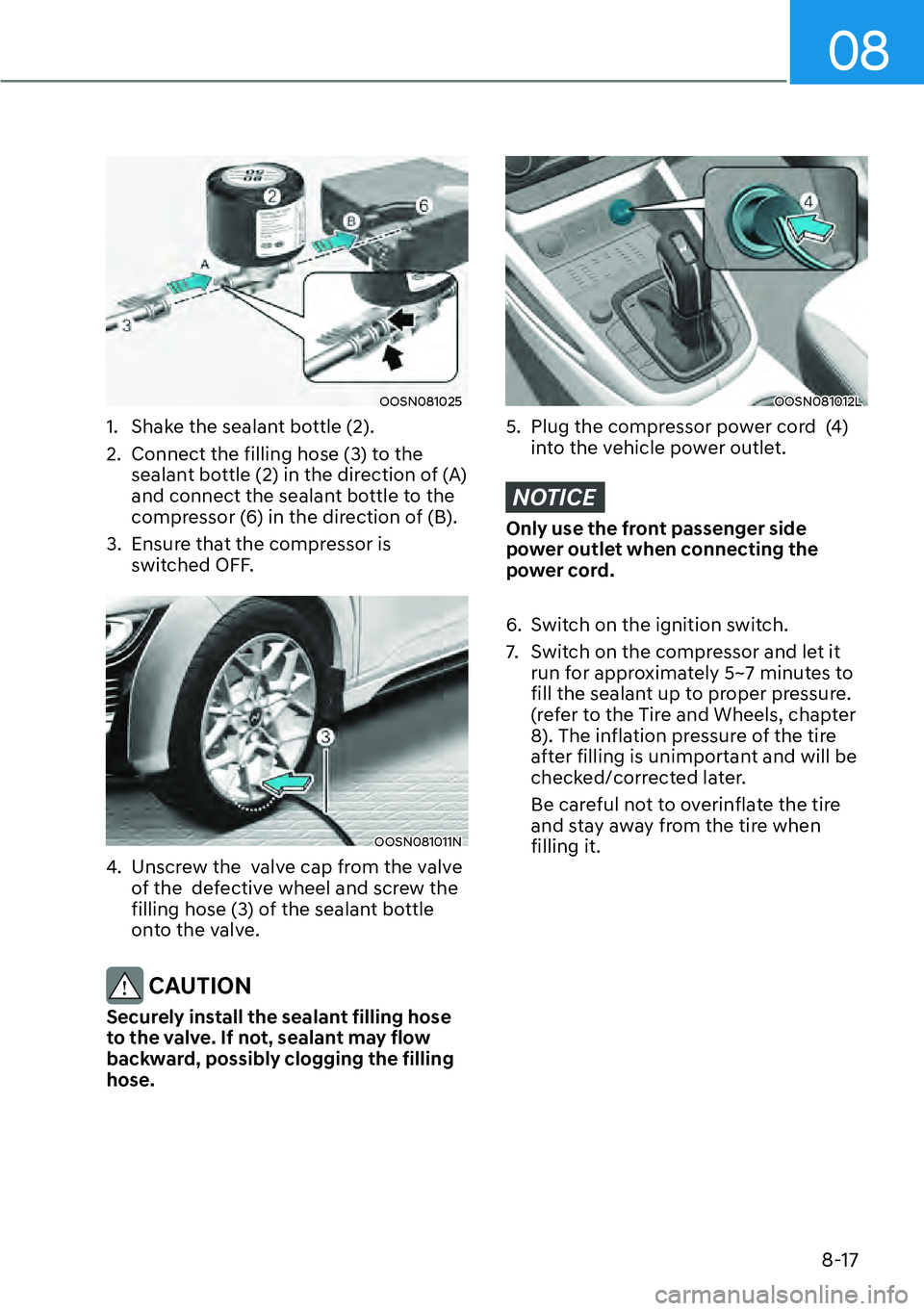
08
8-17
OOSN081025
1. Shake the sealant bottle (2).
2. Connect the filling hose (3) to the sealant bottle (2) in the direction of (A)
and connect the sealant bottle to the
compressor (6) in the direction of (B).
3. Ensure that the compressor is switched OFF.
OOSN081011N
4. Unscrew the valve cap from the valve of the defective wheel and screw the
filling hose (3) of the sealant bottle
onto the valve.
CAUTION
Securely install the sealant filling hose
to the valve. If not, sealant may flow
backward, possibly clogging the filling
hose.
OOSN081012L
5. Plug the compressor power cord (4) into the vehicle power outlet.
NOTICE
Only use the front passenger side
power outlet when connecting the
power cord.
6. Switch on the ignition switch.
7. Switch on the compressor and let it run for approximately 5~7 minutes to
fill the sealant up to proper pressure.
(refer to the Tire and Wheels, chapter
8). The inflation pressure of the tire
after filling is unimportant and will be
checked/corrected later.
Be careful not to overinflate the tire
and stay away from the tire when
filling it.
Page 381 of 478
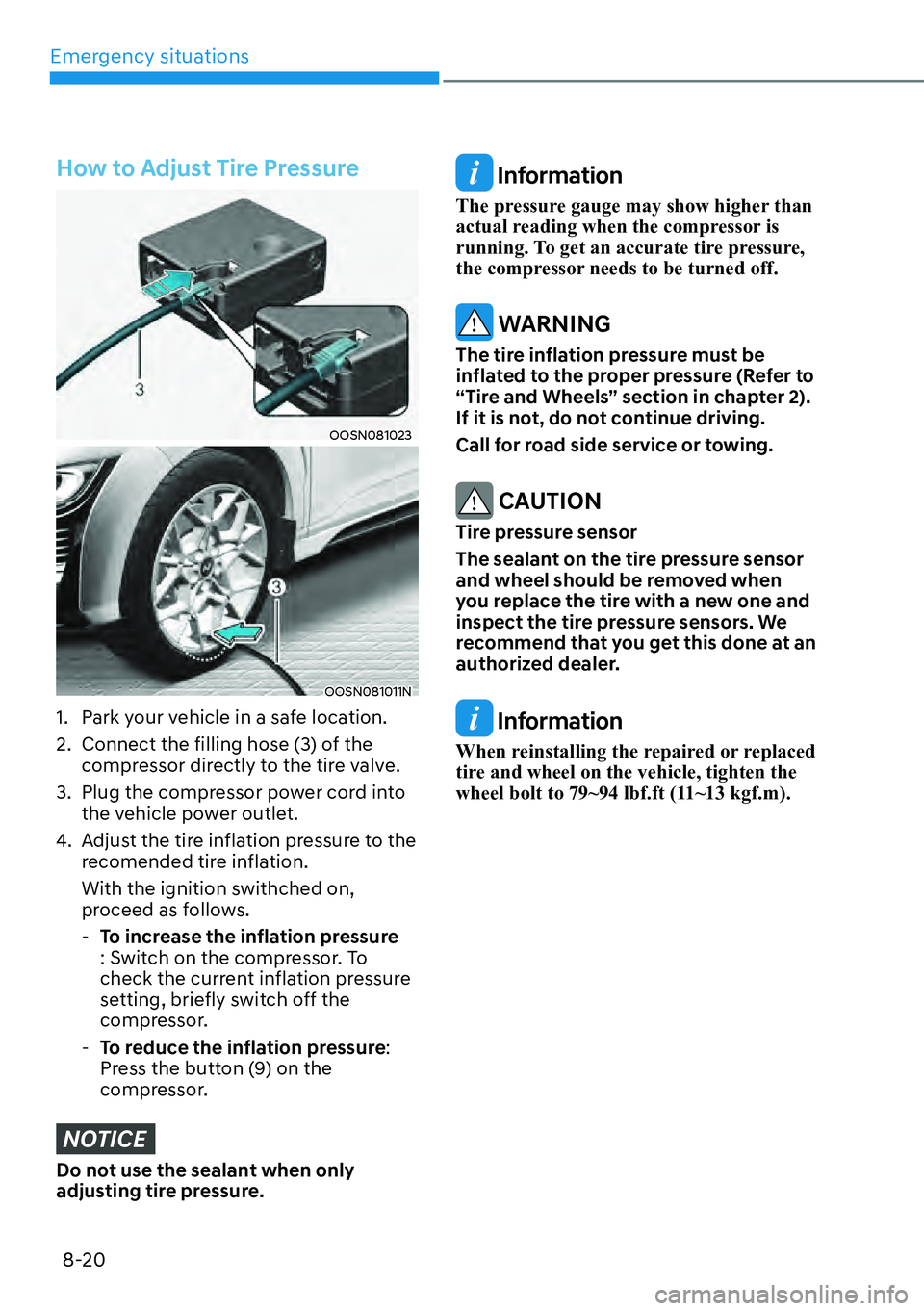
Emergency situations8-20
How to Adjust Tire Pressure
OOSN081023
OOSN081011N
1. Park your vehicle in a safe location.
2. Connect the filling hose (3) of the compressor directly to the tire valve.
3. Plug the compressor power cord into the vehicle power outlet.
4. Adjust the tire inflation pressure to the recomended tire inflation.
With the ignition swithched on,
proceed as follows.
- To increase the inflation pressure
: Switch on the compressor. To
check the current inflation pressure
setting, briefly switch off the
compressor.
- To reduce the inflation pressure :
Press the button (9) on the
compressor.
NOTICE
Do not use the sealant when only
adjusting tire pressure.
Information
The pressure gauge may show higher than
actual reading when the compressor is
running. To get an accurate tire pressure,
the compressor needs to be turned off.
WARNING
The tire inflation pressure must be
inflated to the proper pressure (Refer to
“Tire and Wheels” section in chapter 2).
If it is not, do not continue driving.
Call for road side service or towing.
CAUTION
Tire pressure sensor
The sealant on the tire pressure sensor
and wheel should be removed when
you replace the tire with a new one and
inspect the tire pressure sensors. We
recommend that you get this done at an
authorized dealer.
Information
When reinstalling the repaired or replaced
tire and wheel on the vehicle, tighten the
wheel bolt to 79~94 lbf.ft (11~13 kgf.m).
Page 382 of 478
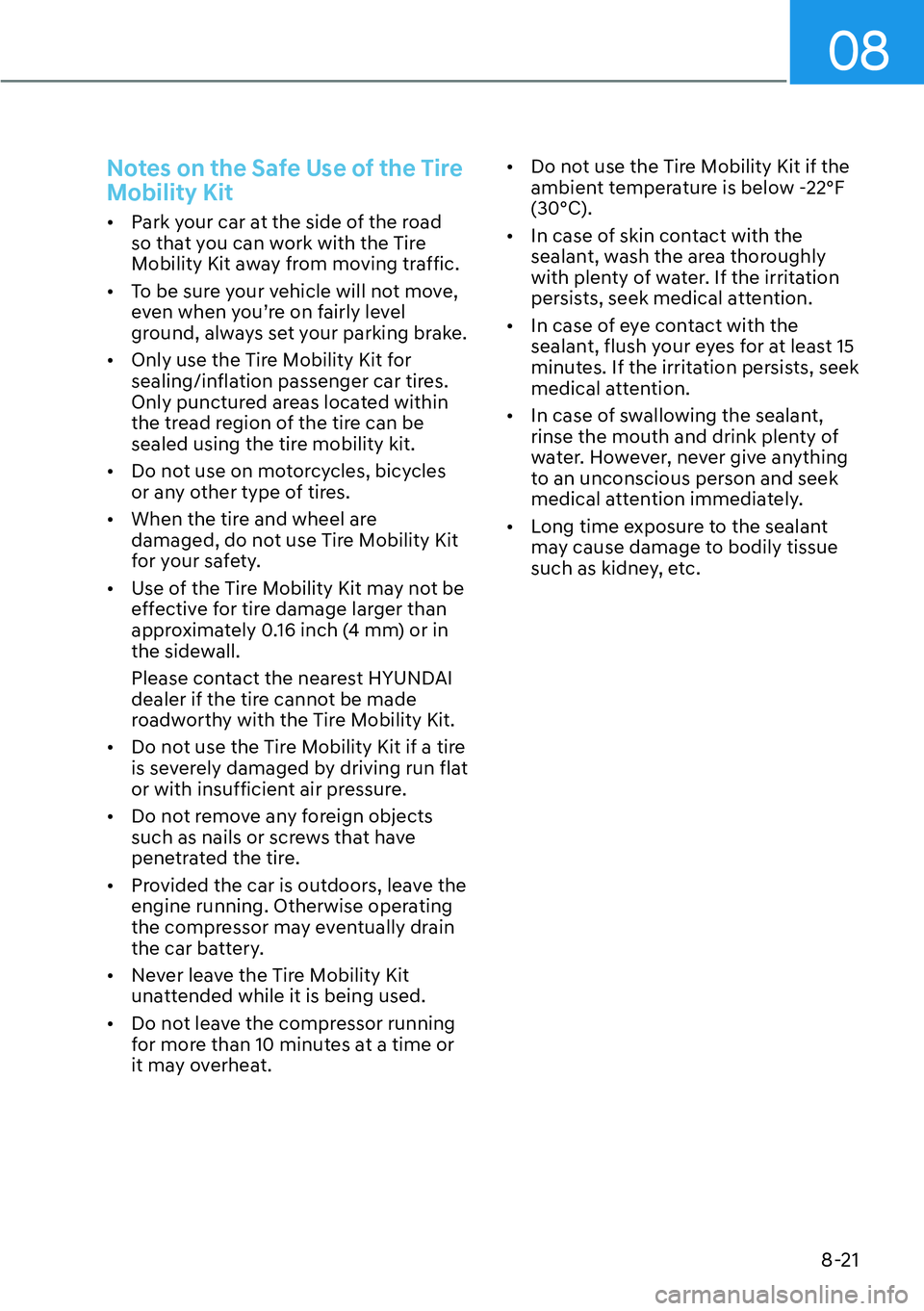
08
8-21
Notes on the Safe Use of the Tire
Mobility Kit
�[��Park your car at the side of the road
so that you can work with the Tire
Mobility Kit away from moving traffic.
�[�� To be sure your vehicle will not move,
even when you’re on fairly level
ground, always set your parking brake.
�[�� Only use the Tire Mobility Kit for
sealing/inflation passenger car tires.
Only punctured areas located within
the tread region of the tire can be
sealed using the tire mobility kit.
�[�� Do not use on motorcycles, bicycles
or any other type of tires.
�[�� When the tire and wheel are
damaged, do not use Tire Mobility Kit
for your safety.
�[�� Use of the Tire Mobility Kit may not be
effective for tire damage larger than
approximately 0.16 inch (4 mm) or in
the sidewall.
Please contact the nearest HYUNDAI
dealer if the tire cannot be made
roadworthy with the Tire Mobility Kit.
�[�� Do not use the Tire Mobility Kit if a tire
is severely damaged by driving run flat
or with insufficient air pressure.
�[�� Do not remove any foreign objects
such as nails or screws that have
penetrated the tire.
�[�� Provided the car is outdoors, leave the
engine running. Otherwise operating
the compressor may eventually drain
the car battery.
�[�� Never leave the Tire Mobility Kit
unattended while it is being used.
�[�� Do not leave the compressor running
for more than 10 minutes at a time or
it may overheat. �[��
Do not use the Tire Mobility Kit if the
ambient temperature is below -22°F
(30°C).
�[�� In case of skin contact with the
sealant, wash the area thoroughly
with plenty of water. If the irritation
persists, seek medical attention.
�[�� In case of eye contact with the
sealant, flush your eyes for at least 15
minutes. If the irritation persists, seek
medical attention.
�[�� In case of swallowing the sealant,
rinse the mouth and drink plenty of
water. However, never give anything
to an unconscious person and seek
medical attention immediately.
�[�� Long time exposure to the sealant
may cause damage to bodily tissue
such as kidney, etc.
Page 383 of 478
![HYUNDAI KONA 2023 Owners Manual Emergency situations8-22
TOWING
Towing Service
OOS067007L[A] : Dollies
If emergency towing is necessary,
we recommend having it done by
an authorized HYUNDAI dealer or a
commercial tow-truck servic HYUNDAI KONA 2023 Owners Manual Emergency situations8-22
TOWING
Towing Service
OOS067007L[A] : Dollies
If emergency towing is necessary,
we recommend having it done by
an authorized HYUNDAI dealer or a
commercial tow-truck servic](/manual-img/35/56169/w960_56169-382.png)
Emergency situations8-22
TOWING
Towing Service
OOS067007L[A] : Dollies
If emergency towing is necessary,
we recommend having it done by
an authorized HYUNDAI dealer or a
commercial tow-truck service.
Proper lifting and towing procedures
are necessary to prevent damage to
the vehicle. The use of wheel dollies or
flatbed is recommended.
For 2WD vehicles, it is acceptable to tow
the vehicle with the rear wheels on the
ground (without dollies) and the front
wheels off the ground.
If any of the loaded wheels or suspension
components are damaged or the vehicle
is being towed with the rear wheels on
the ground, use a towing dolly under the
rear wheels.
When being towed by a commercial tow
truck and wheel dollies are not used,
the front of the vehicle should always be
lifted, not the rear.
NOTICE
Do not lift the vehicle by the tow fitting
or body and chassis parts. Otherwise
the vehicle may be damaged.
CAUTION
�[�� Do not tow the vehicle with the front
wheels on the ground as this may
cause damage to the vehicle.
OOS067022
�[��Do not tow with sling-type
equipment. Use wheel lift or flatbed
equipment.
OOS067021
Page 384 of 478
08
8-23
WARNING
If your vehicle is equipped with a
rollover sensor, set the Engine Start/
Stop button in the OFF or ACC position
when the vehicle is being towed.
The side impact and curtain air bag
may deploy if the sensor detects the
situation as a rollover.
When towing your vehicle in an
emergency without wheel dollies:
1. Set the Engine Start/Stop button in the ACC position.
2. Place the shift lever in N (Neutral).
3. Release the parking brake.
CAUTION
Failure to place the shift lever in N
(Neutral) when being towed with the
front wheels on the ground can cause
internal damage to the transmission.
Removable Towing Hook
���„Front
OOSN081008N
���„Rear
OOSN081009L
1. Open the liftgate, and remove the towing hook from the tool case.
2. Remove the hole cover pressing the lower part of the cover on the front or
rear bumper.
3. Install the towing hook by turning it clockwise into the hole until it is fully
secured.
4. Remove the towing hook and install the cover after use.
Page 385 of 478
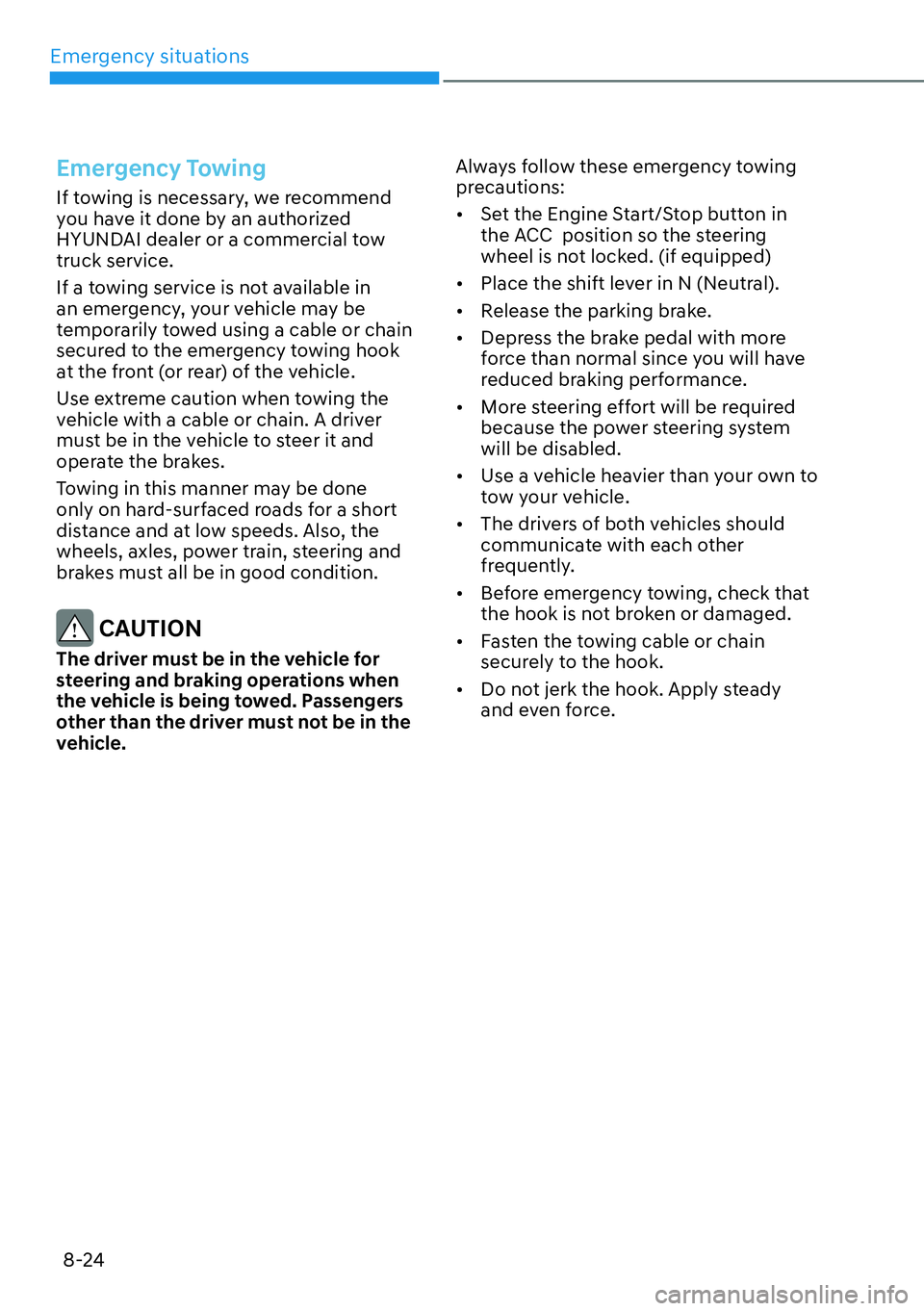
Emergency situations8-24
Emergency Towing
If towing is necessary, we recommend
you have it done by an authorized
HYUNDAI dealer or a commercial tow
truck service.
If a towing service is not available in
an emergency, your vehicle may be
temporarily towed using a cable or chain
secured to the emergency towing hook
at the front (or rear) of the vehicle.
Use extreme caution when towing the
vehicle with a cable or chain. A driver
must be in the vehicle to steer it and
operate the brakes.
Towing in this manner may be done
only on hard-surfaced roads for a short
distance and at low speeds. Also, the
wheels, axles, power train, steering and
brakes must all be in good condition.
CAUTION
The driver must be in the vehicle for
steering and braking operations when
the vehicle is being towed. Passengers
other than the driver must not be in the
vehicle. Always follow these emergency towing
precautions:
�[��
Set the Engine Start/Stop button in
the ACC position so the steering
wheel is not locked. (if equipped)
�[�� Place the shift lever in N (Neutral).
�[�� Release the parking brake.
�[�� Depress the brake pedal with more
force than normal since you will have
reduced braking performance.
�[�� More steering effort will be required
because the power steering system
will be disabled.
�[�� Use a vehicle heavier than your own to
tow your vehicle.
�[�� The drivers of both vehicles should
communicate with each other
frequently.
�[�� Before emergency towing, check that
the hook is not broken or damaged.
�[�� Fasten the towing cable or chain
securely to the hook.
�[�� Do not jerk the hook. Apply steady
and even force.